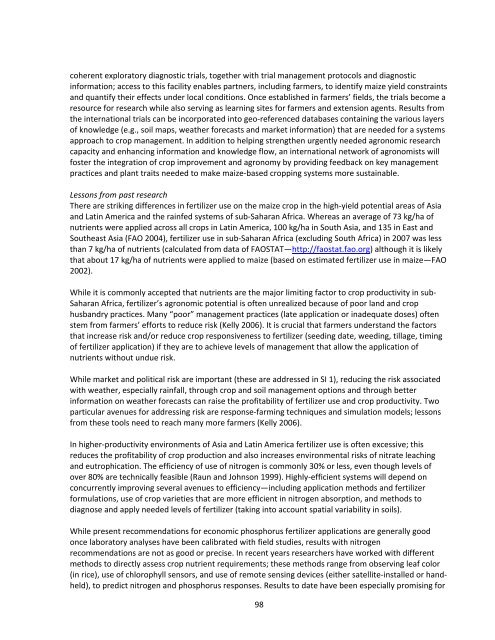Download - Maize
Download - Maize
Download - Maize
You also want an ePaper? Increase the reach of your titles
YUMPU automatically turns print PDFs into web optimized ePapers that Google loves.
coherent exploratory diagnostic trials, together with trial management protocols and diagnostic<br />
information; access to this facility enables partners, including farmers, to identify maize yield constraints<br />
and quantify their effects under local conditions. Once established in farmers’ fields, the trials become a<br />
resource for research while also serving as learning sites for farmers and extension agents. Results from<br />
the international trials can be incorporated into geo‐referenced databases containing the various layers<br />
of knowledge (e.g., soil maps, weather forecasts and market information) that are needed for a systems<br />
approach to crop management. In addition to helping strengthen urgently needed agronomic research<br />
capacity and enhancing information and knowledge flow, an international network of agronomists will<br />
foster the integration of crop improvement and agronomy by providing feedback on key management<br />
practices and plant traits needed to make maize‐based cropping systems more sustainable.<br />
Lessons from past research<br />
There are striking differences in fertilizer use on the maize crop in the high‐yield potential areas of Asia<br />
and Latin America and the rainfed systems of sub‐Saharan Africa. Whereas an average of 73 kg/ha of<br />
nutrients were applied across all crops in Latin America, 100 kg/ha in South Asia, and 135 in East and<br />
Southeast Asia (FAO 2004), fertilizer use in sub‐Saharan Africa (excluding South Africa) in 2007 was less<br />
than 7 kg/ha of nutrients (calculated from data of FAOSTAT—http://faostat.fao.org) although it is likely<br />
that about 17 kg/ha of nutrients were applied to maize (based on estimated fertilizer use in maize—FAO<br />
2002).<br />
While it is commonly accepted that nutrients are the major limiting factor to crop productivity in sub‐<br />
Saharan Africa, fertilizer’s agronomic potential is often unrealized because of poor land and crop<br />
husbandry practices. Many “poor” management practices (late application or inadequate doses) often<br />
stem from farmers’ efforts to reduce risk (Kelly 2006). It is crucial that farmers understand the factors<br />
that increase risk and/or reduce crop responsiveness to fertilizer (seeding date, weeding, tillage, timing<br />
of fertilizer application) if they are to achieve levels of management that allow the application of<br />
nutrients without undue risk.<br />
While market and political risk are important (these are addressed in SI 1), reducing the risk associated<br />
with weather, especially rainfall, through crop and soil management options and through better<br />
information on weather forecasts can raise the profitability of fertilizer use and crop productivity. Two<br />
particular avenues for addressing risk are response‐farming techniques and simulation models; lessons<br />
from these tools need to reach many more farmers (Kelly 2006).<br />
In higher‐productivity environments of Asia and Latin America fertilizer use is often excessive; this<br />
reduces the profitability of crop production and also increases environmental risks of nitrate leaching<br />
and eutrophication. The efficiency of use of nitrogen is commonly 30% or less, even though levels of<br />
over 80% are technically feasible (Raun and Johnson 1999). Highly‐efficient systems will depend on<br />
concurrently improving several avenues to efficiency—including application methods and fertilizer<br />
formulations, use of crop varieties that are more efficient in nitrogen absorption, and methods to<br />
diagnose and apply needed levels of fertilizer (taking into account spatial variability in soils).<br />
While present recommendations for economic phosphorus fertilizer applications are generally good<br />
once laboratory analyses have been calibrated with field studies, results with nitrogen<br />
recommendations are not as good or precise. In recent years researchers have worked with different<br />
methods to directly assess crop nutrient requirements; these methods range from observing leaf color<br />
(in rice), use of chlorophyll sensors, and use of remote sensing devices (either satellite‐installed or handheld),<br />
to predict nitrogen and phosphorus responses. Results to date have been especially promising for<br />
98

















